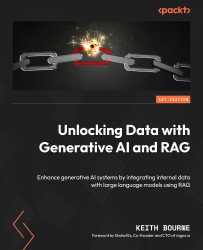Generative AI, with its ability to create novel text, images, and even code, has revolutionized many industries. However, traditional generative AI models often struggle with factual accuracy and can produce outputs that are biased, hallucinatory, or outdated. This is where Retrieval-Augmented Generation (RAG) emerges as a powerful solution, enabling AI models to access and utilize external knowledge sources to generate more accurate, informative, and reliable outputs. This white paper explores the principles of RAG, its key benefits, and its transformative potential across various domains.
Unlocking Data with Generative AI and Retrieval-Augmented Generation (RAG)
1. Introduction
Generative AI, with its ability to create novel text, images, and even code, has revolutionized many industries. However, traditional generative AI models often struggle with factual accuracy and can produce outputs that are biased, hallucinatory, or outdated. This is where Retrieval-Augmented Generation (RAG) emerges as a powerful solution, enabling AI models to access and utilize external knowledge sources to generate more accurate, informative, and reliable outputs. This white paper explores the principles of RAG, its key benefits, and its transformative potential across various domains.
2. The Limitations of Traditional Generative AI
- Hallucinations: Generative AI models can sometimes fabricate information or generate outputs that are factually incorrect.
- Lack of Factual Grounding: AI models may not always have access to the most up-to-date or relevant information to support their responses.
- Bias and Fairness: Trained on massive datasets, these models can inadvertently reflect biases present in the training data, leading to unfair or discriminatory outputs.
- Lack of Explainability: It can be difficult to understand how a generative AI model arrives at a particular output, making it challenging to identify and correct errors.
3. The Power of Retrieval-Augmented Generation (RAG)
RAG addresses these limitations by:
- Integrating External Knowledge: RAG systems allow AI models to access and utilize external knowledge sources such as databases, documents, and other relevant information repositories.
- Improving Factual Accuracy: By grounding AI outputs in real-world data, RAG significantly improves the accuracy and reliability of the generated content.
- Enhancing Contextual Awareness: RAG enables AI models to better understand the context of user queries and provide more relevant and informative responses.
- Increasing Explainability: By identifying the specific sources used to generate an output, RAG enhances the transparency and explainability of the AI system.
4. Key Components of a RAG System
- Retrieval Module: This component is responsible for efficiently retrieving relevant information from the knowledge base in response to user queries or prompts. Techniques such as vector search, semantic search, and keyword matching are commonly used.
- Generative Model: A powerful language model (like a large language model - LLM) that generates text, translates languages, writes different kinds of creative content, and answers your questions in an informative1 way.
- Fusion Module: This component combines the retrieved information with the input prompt to generate the final output. This may involve techniques like attention mechanisms, where the model learns to weigh the importance of different pieces of retrieved information.
5. Use Cases of RAG
- Customer Service: Powering chatbots and virtual assistants with accurate and up-to-date information about products, services, and company policies.
- Financial Services: Providing personalized financial advice, answering customer inquiries, and detecting fraud based on real-time market data.
- Healthcare: Assisting doctors and researchers in analyzing medical literature, diagnosing diseases, and developing personalized treatment plans.
- E-commerce: Providing personalized product recommendations, answering customer questions, and generating compelling product descriptions.
- Legal: Assisting lawyers in legal research, drafting contracts, and analyzing legal documents.
- Education: Creating personalized learning experiences, answering student questions, and providing customized educational content.
6. Challenges and Considerations
- Data Quality and Relevance: Ensuring the quality, accuracy, and relevance of the information stored in the knowledge base is crucial for the effectiveness of RAG systems.
- Scalability and Performance: Handling large volumes of data and ensuring fast retrieval times can be challenging.
- Bias and Fairness: Addressing potential biases in the retrieved data and ensuring that the RAG system generates fair and unbiased outputs.
- Explainability and Interpretability: Developing techniques to better understand and explain the reasoning behind the RAG system's outputs.
7. Future Directions
- Continuous Learning and Adaptation: Developing RAG systems that can continuously learn and adapt to new information and changing user needs.
- Multimodal RAG: Extending RAG to incorporate other forms of data, such as images, audio, and video.
- Explainable RAG: Developing techniques to make the reasoning and decision-making processes of RAG systems more transparent and understandable.
8. References
- "Retrieval-Augmented Generation for Knowledge-Intensive NLP Tasks" by Kenton Lee et al. (Google AI Blog)
- "Retrieval-Augmented Generation for Conversational AI" by Eric Wang et al. (Google AI Blog)
- "Retrieval-Augmented Generation for Question Answering" by Chen et al. (ACL 2020)
- "Large Language Models" by Yann LeCun (Facebook AI Research)
- "Deep Learning" by Ian Goodfellow, Yoshua Bengio, and Aaron Courville
Disclaimer: This white paper provides a general overview of Retrieval-Augmented Generation (RAG) and its potential applications. The specific implementation and performance of RAG systems will vary depending on the specific use case, the quality of the knowledge base, and the capabilities of the underlying AI model.
This information is for general knowledge and informational purposes only.
